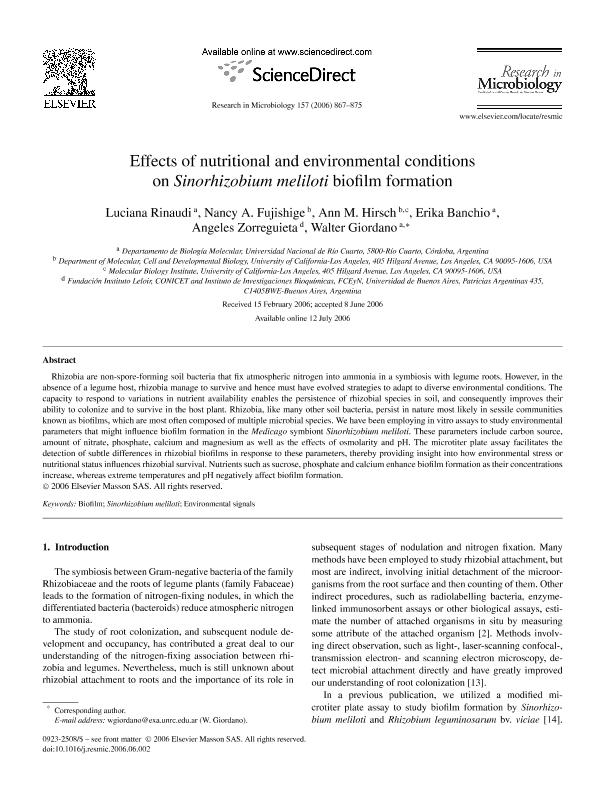Mostrar el registro sencillo del ítem
dc.contributor.author
Rinaudi, Luciana Veronica

dc.contributor.author
Fujishige, Nancy A.
dc.contributor.author
Hirsch, Ann M.
dc.contributor.author
Banchio, Erika

dc.contributor.author
Zorreguieta, Ángeles

dc.contributor.author
Giordano, Walter Fabian

dc.date.available
2018-03-20T19:03:48Z
dc.date.issued
2006-11
dc.identifier.citation
Rinaudi, Luciana Veronica; Fujishige, Nancy A.; Hirsch, Ann M.; Banchio, Erika; Zorreguieta, Ángeles; et al.; Effects of nutritional and environmental conditions on Sinorhizobium meliloti biofilm formation; Elsevier Science; Research In Microbiology; 157; 9; 11-2006; 867-875
dc.identifier.issn
0923-2508
dc.identifier.uri
http://hdl.handle.net/11336/39406
dc.description.abstract
Rhizobia are non-spore-forming soil bacteria that fix atmospheric nitrogen into ammonia in a symbiosis with legume roots. However, in the absence of a legume host, rhizobia manage to survive and hence must have evolved strategies to adapt to diverse environmental conditions. The capacity to respond to variations in nutrient availability enables the persistence of rhizobial species in soil, and consequently improves their ability to colonize and to survive in the host plant. Rhizobia, like many other soil bacteria, persist in nature most likely in sessile communities known as biofilms, which are most often composed of multiple microbial species. We have been employing in vitro assays to study environmental parameters that might influence biofilm formation in the Medicago symbiont Sinorhizobium meliloti. These parameters include carbon source, amount of nitrate, phosphate, calcium and magnesium as well as the effects of osmolarity and pH. The microtiter plate assay facilitates the detection of subtle differences in rhizobial biofilms in response to these parameters, thereby providing insight into how environmental stress or nutritional status influences rhizobial survival. Nutrients such as sucrose, phosphate and calcium enhance biofilm formation as their concentrations increase, whereas extreme temperatures and pH negatively affect biofilm formation.
dc.format
application/pdf
dc.language.iso
eng
dc.publisher
Elsevier Science

dc.rights
info:eu-repo/semantics/openAccess
dc.rights.uri
https://creativecommons.org/licenses/by-nc-sa/2.5/ar/
dc.subject
Biofilm
dc.subject
Environmental Signals
dc.subject
Sinorhizobium Meliloti
dc.subject.classification
Otras Ciencias Biológicas

dc.subject.classification
Ciencias Biológicas

dc.subject.classification
CIENCIAS NATURALES Y EXACTAS

dc.title
Effects of nutritional and environmental conditions on Sinorhizobium meliloti biofilm formation
dc.type
info:eu-repo/semantics/article
dc.type
info:ar-repo/semantics/artículo
dc.type
info:eu-repo/semantics/publishedVersion
dc.date.updated
2018-03-15T18:03:42Z
dc.identifier.eissn
1769-7123
dc.journal.volume
157
dc.journal.number
9
dc.journal.pagination
867-875
dc.journal.pais
Países Bajos

dc.journal.ciudad
Amsterdam
dc.description.fil
Fil: Rinaudi, Luciana Veronica. Universidad Nacional de Río Cuarto; Argentina
dc.description.fil
Fil: Fujishige, Nancy A.. University of California; Estados Unidos
dc.description.fil
Fil: Hirsch, Ann M.. University of California; Estados Unidos
dc.description.fil
Fil: Banchio, Erika. Universidad Nacional de Río Cuarto; Argentina
dc.description.fil
Fil: Zorreguieta, Ángeles. Consejo Nacional de Investigaciones Científicas y Técnicas. Oficina de Coordinación Administrativa Parque Centenario. Instituto de Investigaciones Bioquímicas de Buenos Aires. Fundación Instituto Leloir. Instituto de Investigaciones Bioquímicas de Buenos Aires; Argentina
dc.description.fil
Fil: Giordano, Walter Fabian. Universidad Nacional de Río Cuarto; Argentina
dc.journal.title
Research In Microbiology

dc.relation.alternativeid
info:eu-repo/semantics/altIdentifier/url/https://www.sciencedirect.com/science/article/pii/S0923250806001264
dc.relation.alternativeid
info:eu-repo/semantics/altIdentifier/doi/http://dx.doi.org/10.1016/j.resmic.2006.06.002
Archivos asociados
